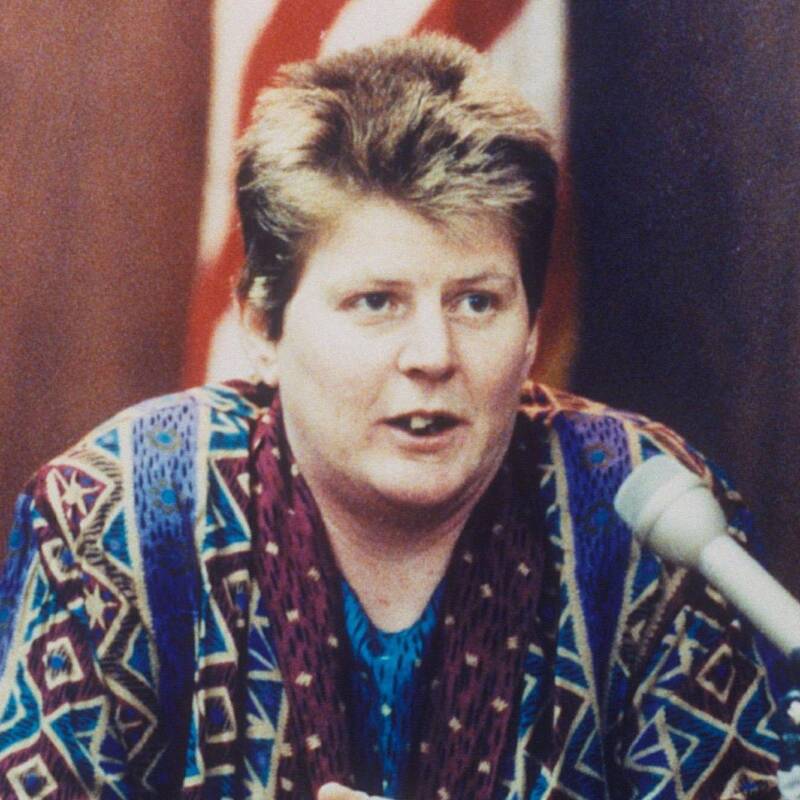Aileen Wuornos And Tyria Moore: The Dark Realities Of Female Serial Killers
When you hear the name Aileen Wuornos, images of crime scenes, headlines, and even the Academy Award-winning movie "Monster" might flash through your mind. But what about Tyria Moore? Together, they form one of the most infamous duos in the annals of true crime history. Their story is not just about the darkness that lurks within, but also the societal forces that shaped their lives. In this article, we’ll dive deep into their world, explore their crimes, and uncover the truths behind the headlines.
This ain’t just another true crime story; it’s a journey into the complexities of human nature. We’re talking about two women whose lives became entangled in a web of violence, desperation, and survival. Their actions shocked the nation, but beneath the headlines lies a tale of trauma, addiction, and the failure of systems meant to protect them.
As we unravel the layers of their stories, we’ll also examine the broader implications of their crimes. How do we understand the motivations of female serial killers? What role does society play in creating monsters? Stick around, because this is gonna be a wild ride.
Read also:Noodlemagzine Your Ultimate Guide To Exploring The World Of Noodles
Biography: Aileen Wuornos and Tyria Moore
Before we dive into the gritty details of their crimes, let’s take a step back and get to know the women behind the headlines. Aileen Wuornos and Tyria Moore were unlikely partners in crime, but their lives were intertwined by shared struggles and a desperate need to survive.
Who Were Aileen Wuornos and Tyria Moore?
Aileen Carol Wuornos was born on February 29, 1956, in Rochester, Michigan. From the very beginning, her life was marked by trauma and instability. Her father, Leo, was a convicted child molester who committed suicide in prison, while her mother abandoned her as a child. Aileen’s early years were spent in foster care, where she experienced neglect and abuse. By the time she was a teenager, she had already turned to prostitution to survive.
Tyria Moore, on the other hand, was born on March 12, 1957, in Dayton, Ohio. Unlike Aileen, Tyria came from a relatively stable family, but her life took a dark turn when she became involved with drugs and prostitution. It was during this time that she met Aileen Wuornos, and their fateful partnership began.
Data and Facts About Aileen Wuornos and Tyria Moore
| Name | Date of Birth | Place of Birth | Occupation | Notable Crimes |
|---|---|---|---|---|
| Aileen Wuornos | February 29, 1956 | Rochester, Michigan | Prostitute, Serial Killer | Murder of seven men in Florida |
| Tyria Moore | March 12, 1957 | Dayton, Ohio | Prostitute, Accomplice | Accused of aiding Aileen Wuornos |
The Crimes: A Glimpse into the Darkness
Between 1989 and 1990, Aileen Wuornos and Tyria Moore allegedly murdered seven men in Florida. These murders sent shockwaves through the nation and sparked a media frenzy. But what drove these women to commit such heinous acts? Let’s break it down.
How It All Began
Their crime spree began with Richard Mallory, a 35-year-old man who was found dead in a wooded area near Titusville, Florida. Mallory had been shot multiple times, and his car was discovered nearby. It wasn’t long before the authorities connected the dots and identified Aileen Wuornos as the prime suspect.
- Richard Mallory – Victim #1
- Peter Siemienowicz – Victim #2
- David Spears – Victim #3
- Charles Carskaddon – Victim #4
- Troy Burress – Victim #5
- Benjamin Walker – Victim #6
- Walter Gino Antonio – Victim #7
Each victim had one thing in common: they were all picked up by Aileen Wuornos while she was working as a prostitute. According to Aileen, she acted in self-defense, claiming that the men had attempted to rape or harm her. However, the evidence told a different story.
Read also:How Old Was Rihanna In 2005 Lets Dive Into Her Journey And Early Fame
The Role of Tyria Moore
Tyria Moore’s involvement in the crimes remains a topic of debate. While Aileen claimed that Tyria was unaware of her actions, prosecutors argued that Tyria played an active role in the murders. In fact, Tyria was charged as an accomplice and faced significant legal consequences.
Here’s the kicker: Tyria eventually struck a deal with prosecutors, testifying against Aileen in exchange for a reduced sentence. This decision would prove pivotal in Aileen’s trial and ultimate conviction.
Understanding the Motivations
What drives someone to become a serial killer? For Aileen Wuornos and Tyria Moore, the answer lies in a complex mix of trauma, addiction, and survival. Let’s explore the psychological factors that contributed to their actions.
The Trauma Factor
Trauma plays a significant role in shaping human behavior, and both Aileen and Tyria experienced severe trauma in their early lives. Aileen’s childhood was marred by neglect and abuse, while Tyria’s involvement in the drug world exposed her to violence and exploitation. These experiences likely contributed to their inability to form healthy relationships and cope with adversity.
A study published in the Journal of Forensic Sciences highlights the link between childhood trauma and violent behavior. According to the study, individuals who experience severe trauma are more likely to engage in violent acts later in life. This doesn’t excuse their actions, but it does provide some context for understanding their motivations.
Addiction and Survival
Both Aileen and Tyria struggled with addiction, which further complicated their lives. Prostitution became their means of survival, but it also exposed them to dangerous situations. Aileen claimed that she killed in self-defense, but the evidence suggests otherwise.
Experts in the field of criminology point out that addiction can impair judgment and increase the likelihood of violent behavior. In Aileen’s case, her addiction to drugs and alcohol may have clouded her ability to make rational decisions.
The Legal Battle
When Aileen Wuornos was arrested in 1991, her case quickly became a media sensation. The trial was a rollercoaster of emotions, with Aileen delivering a series of dramatic and often contradictory statements. Let’s take a closer look at the legal proceedings and their aftermath.
Aileen Wuornos on Trial
Aileen’s trial was a high-stakes affair, with the prosecution seeking the death penalty. The defense argued that Aileen acted in self-defense, but the evidence against her was overwhelming. Ballistic tests confirmed that the bullets recovered from the victims’ bodies matched Aileen’s gun, and Tyria Moore’s testimony sealed her fate.
In 1992, Aileen was convicted of six counts of first-degree murder and sentenced to death. Over the years, she would face additional trials for the remaining murders, ultimately receiving three more death sentences.
Tyria Moore’s Deal
Tyria Moore’s decision to testify against Aileen was a calculated move. By cooperating with prosecutors, she avoided the death penalty and received a lighter sentence. Some critics argue that Tyria’s deal was unethical, given her close relationship with Aileen, but others believe it was a necessary step in securing justice for the victims.
Public Reaction and Legacy
The story of Aileen Wuornos and Tyria Moore captivated the nation, sparking heated debates about the nature of evil and the role of society in creating monsters. But how has their legacy endured over the years?
The Media Sensation
From the moment Aileen was arrested, her case became a media sensation. The public was fascinated by the idea of a female serial killer, a rarity in the world of true crime. Movies, documentaries, and books have been written about her life, cementing her place in the annals of criminal history.
Charlize Theron’s portrayal of Aileen in the movie "Monster" brought renewed attention to her story, earning the actress an Academy Award for her performance. The film shed light on the complexities of Aileen’s character, humanizing her in ways that the headlines never could.
The Broader Implications
Aileen Wuornos and Tyria Moore’s story raises important questions about the treatment of women in the criminal justice system. How do we address the root causes of crime, such as trauma and addiction? And what role does society play in creating environments where such crimes can occur?
According to a report by the National Institute of Justice, women in the criminal justice system often face unique challenges, including higher rates of trauma and mental health issues. Addressing these issues requires a comprehensive approach that goes beyond punishment and focuses on rehabilitation and support.
Conclusion: Lessons from the Darkness
In the end, the story of Aileen Wuornos and Tyria Moore is a cautionary tale about the consequences of trauma, addiction, and societal neglect. While their actions were undeniably heinous, their stories also highlight the need for empathy and understanding in addressing the root causes of crime.
As we reflect on their legacy, let’s not forget the victims and their families, whose lives were forever changed by these tragic events. If you found this article informative, I encourage you to share it with others and continue the conversation. Together, we can work towards a world where such stories are no longer the norm.
Table of Contents
- Biography: Aileen Wuornos and Tyria Moore
- The Crimes: A Glimpse into the Darkness
- Understanding the Motivations
- The Legal Battle
- Public Reaction and Legacy
- Conclusion: Lessons from the Darkness
So, there you have it folks. A deep dive into the world of Aileen Wuornos and Tyria Moore. Let’s keep the conversation going and remember that every story has layers waiting to be uncovered.



